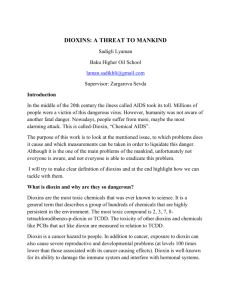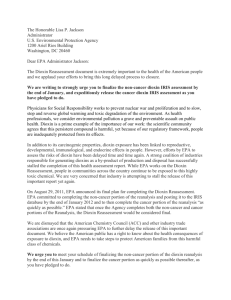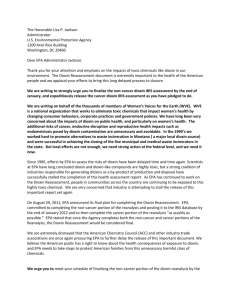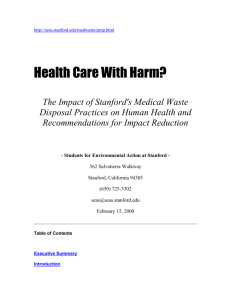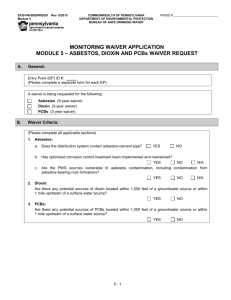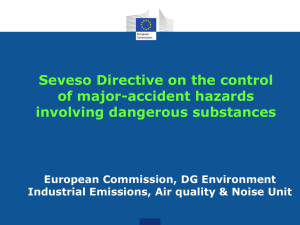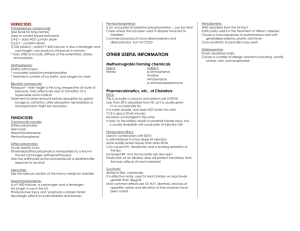A sociological analysis of dioxin pollution in Seveso (Italy)
advertisement
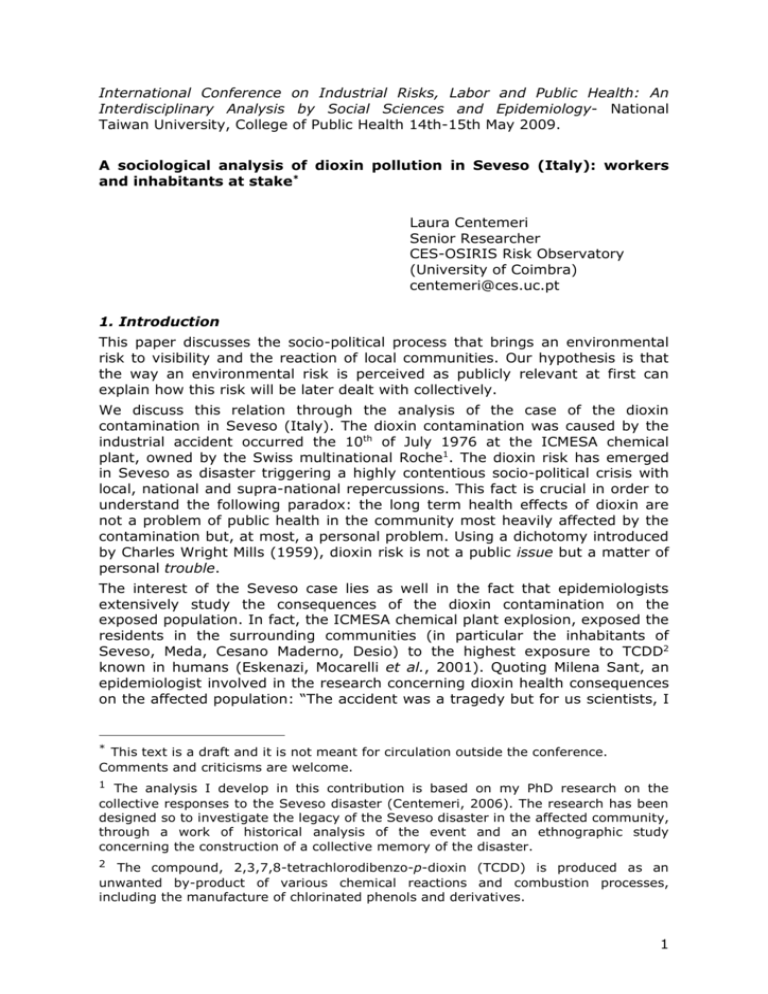
International Conference on Industrial Risks, Labor and Public Health: An Interdisciplinary Analysis by Social Sciences and Epidemiology- National Taiwan University, College of Public Health 14th-15th May 2009. A sociological analysis of dioxin pollution in Seveso (Italy): workers and inhabitants at stake* Laura Centemeri Senior Researcher CES-OSIRIS Risk Observatory (University of Coimbra) centemeri@ces.uc.pt 1. Introduction This paper discusses the socio-political process that brings an environmental risk to visibility and the reaction of local communities. Our hypothesis is that the way an environmental risk is perceived as publicly relevant at first can explain how this risk will be later dealt with collectively. We discuss this relation through the analysis of the case of the dioxin contamination in Seveso (Italy). The dioxin contamination was caused by the industrial accident occurred the 10th of July 1976 at the ICMESA chemical plant, owned by the Swiss multinational Roche1. The dioxin risk has emerged in Seveso as disaster triggering a highly contentious socio-political crisis with local, national and supra-national repercussions. This fact is crucial in order to understand the following paradox: the long term health effects of dioxin are not a problem of public health in the community most heavily affected by the contamination but, at most, a personal problem. Using a dichotomy introduced by Charles Wright Mills (1959), dioxin risk is not a public issue but a matter of personal trouble. The interest of the Seveso case lies as well in the fact that epidemiologists extensively study the consequences of the dioxin contamination on the exposed population. In fact, the ICMESA chemical plant explosion, exposed the residents in the surrounding communities (in particular the inhabitants of Seveso, Meda, Cesano Maderno, Desio) to the highest exposure to TCDD2 known in humans (Eskenazi, Mocarelli et al., 2001). Quoting Milena Sant, an epidemiologist involved in the research concerning dioxin health consequences on the affected population: “The accident was a tragedy but for us scientists, I * This text is a draft and it is not meant for circulation outside the conference. Comments and criticisms are welcome. 1 The analysis I develop in this contribution is based on my PhD research on the collective responses to the Seveso disaster (Centemeri, 2006). The research has been designed so to investigate the legacy of the Seveso disaster in the affected community, through a work of historical analysis of the event and an ethnographic study concerning the construction of a collective memory of the disaster. 2 The compound, 2,3,7,8-tetrachlorodibenzo-p-dioxin (TCDD) is produced as an unwanted by-product of various chemical reactions and combustion processes, including the manufacture of chlorinated phenols and derivatives. 1 must admit, it has been a rare chance to have a sort of laboratory situation, so to explore how dioxin works on human beings”. This vast scientific production concerning dioxin effects in Seveso has no impact in terms of public health measures implemented in the affected territory, especially as far as prevention is involved. At the same time, the affected population has not engaged in collective action in order to ask for a full disclosure of the impact of dioxin contamination. Long term dioxin health effects are not the case for public concern and debate: they are the case mostly of “rumours” circulating in the community or of personal trouble of those persons directly touched by diseases linked to dioxin exposure. In the paper, we discuss how this double framing of dioxin long term health effects -either as a pure scientific problem or as a personal trouble- has emerged. In order to do this, we are going first to analyse the responses to the Seveso disaster, in particular the choices made by public authorities in order to manage the crisis. We will then focus on the local mobilisations and the conflicting interpretations of dioxin risk supported by the mobilised groups. Through investigating the dynamic of these mobilisations and the interplay with public authorities crisis management approach, we show how the dioxin risk was never framed as a problem of public health. We show as well how an interpretation of dioxin as “cultural threat” came to prevail in the affected population. In the final section, we discuss what the Seveso case tells us about the construction of visibility of environmental risks, in particular the role played by the dialogue between scientists, citizens, activists and public authorities. 2. Seveso: the disaster and the public authorities response It is always difficult to give a synthetic description of a disaster and its consequences, when addressing the problem from a sociological point of view. The official “toll of the tragedy” is often an object for endless controversies and, besides, it doesn’t say anything of the impact in the long term the event had on the affected community. A variety of socio-political processes, included framing processes, shape the disaster, making it generative of social change. These processes have different temporalities and they take place in different, but intertwined, arenas: local and global political arenas, experts arenas, in particular legal and scientific (Jasanoff, 1994). For what is of the Seveso disaster, its main feature is that of having being the first major accident in the chemical industry at the European level. This disaster contributed to the definition of the European directive (Directive 82/501/EEC, so-called “Seveso Directive”) on major-accident hazards of certain industrial activities (De Marchi, 1997; De Marchi, Funtowicz and Guimares Pereira, 2001; De Marchi, Funtowicz and Ravetz, 1996). “There were no fatalities following the accident”, said Stavros Dimas, responsible for the environment in the EU Commission, commemorating in 2006 the 30 years after the accident. In fact, at the European level, the Seveso disaster is considered as a “disaster of information” (van Eijndohven, 1994). This disaster helped in highlighting the lack of information about industrial hazardous productions as a major cause of vulnerability in our highly industrialised societies. Quoting again Dimas, “the reason for this particular accident becoming such a symbol is because it exposed the serious flaws in the response to industrial accidents”. The absence of “fatalities” joint with the recovery of the contaminated territory explains as well why eco-sceptic oriented books often 2 cite the Seveso disaster as an example of “unjustified alarmism” (Kohler, 2002). This emphasis on the event of the disaster has completely concealed the reality of a community exposed since 1945 to the chemical pollution caused by the plant. This realty has never been seriously investigated in its human and environmental costs. The harmfulness of the factory, even if known in the local community, became of public concern only with the accident of the July 1976 and merely in terms of the specific consequences of the disaster. Moreover, if there has not been the health catastrophe someone expected back in 1976, nevertheless dioxin contamination has affected people health with various degrees of gravity. The 25 years follow-up study of mortality in the exposed population show excesses of lymphatic and hematopoietic tissue neoplasms, diabetes mellitus, chronic obstructive pulmonary disease (Consonni et al., 2008). The relevant question in the case of Seveso is the following: in spite of the disaster, the long term dioxin health effects have never been the case for public concern and for mobilisation in the affected communities, thus contributing to the public invisibility of the issue. In order to develop our analysis, we need first of all to introduce some elements of contextualisation. Seveso is a town of 20.000 inhabitants, located 15 Km North of Milan, the regional capital of the Lombardy, in the geographical area known as “Brianza Milanese”. The Brianza is a “district area” (Bagnasco, 1977), of strong catholic cultural tradition, specialized in furniture production and design, with a productive structure of small, family-owned firms. Since after World War II, chemical industries began to install their plants in this same area, given the rich water resources and the good transportation infrastructures. The accident at the origin of the Seveso disaster occurred in the chemical plant ICMESA (located in the territory of Meda, near Seveso), 170 workers, owned since 1963 by the Swiss multinational Roche through the controlled Swiss company Givaudan. It produced intermediate compounds for the cosmetics and pharmaceutical industry among which, since 1969 and more intensely in the ‘70s, 2,4,5 trichlorophenol (TCP), a toxic inflammable compound used for the chemical synthesis of herbicides3. Saturday the 10th of July 1976, around half past twelve a.m., the ICMESA reactor where trichlorophenol was produced released a toxic cloud of dioxin and other pollutants, because of a sudden exothermic reaction that caused the breaking down of the safety valve4. A 20 minutes hazardous emission settled on a large area of about 1810 hectares involving the municipalities of Seveso, 3 A question that stays open is the doubt concerning the true destination of the TCP produced by ICMESA. According to journalist Daniele Biacchessi (1997), the TCP produced in the early ‘70’s by ICMESA was transported to the US and used in the production of chemical weapons for the Vietnam war. 4 The air emission originated from a TBC (1,2,3,4 tetrachlorobenzene) alkaline hydrolysis reaction vessel at 2,4,5 sodium trichlorophenate, an intermediate compound in the preparation of trichlorophenol. The direct cause of the emission was excessive pressure induced by an exothermic reaction in the TCP vessel, which occurred few hours after suspending operations and made the disk of a safety valve break down: in fact, the disk broke by reaching 4 atmospheres and, at 250°C, TCDD - together with the above mentioned products, with ethilenic glycol and soda - burst out of the roof spreading directly in the air due to the lack of the expansion chamber (Ramondetta and Repossi, 1998). 3 Meda, Desio, Cesano Maderno and, even though in a less serious way, other seven municipalities of the province of Milan. The 2,3,7,8 tetrachloro-dibenzo-para-dioxin (TCDD), simply called dioxin, released by the ICMESA reactor5 is an extremely dangerous molecule due to its very high toxicity, persistence and stability. Nevertheless, dioxin was little known at the time of the accident. In 1976 the extremely harmful effects of dioxin on human health were mostly supposed, on the basis of toxicological evidence. Epidemiological studies were still few and limited to the follow up of cohorts of industrial workers. A dioxin environmental contamination affecting an entire population was without precedent. Scientists were not able to anticipate the damages to be expected (on the environment, animals, human beings of different sex and ages) nor to supply methods for the decontamination. Besides, there were no technical instruments for measuring the level of dioxin in human blood (Mocarelli, 2001). Therefore a “radical uncertainty” (Callon, Lascoumes and Barthe, 2001) surrounded the contamination consequences to be expected on human health and the environment, their extent in space as well as in time, with just one certainty: the extreme toxicity of dioxin proven in laboratory tests. This latter authorized catastrophic scenarios. These catastrophic scenarios didn’t take shape immediately after the accident. The toxic cloud passed largely unnoticed, considered by Seveso and Meda people as a “usual” nuisance (one in a long series). A “week of silence” (Fratter, 2006) passed by. In the meantime, alarming phenomena took place in the area near ICMESA: sudden falling of leaves; death of small animals (birds and cats); a “mysterious” skin disease (chloracne) affecting children. Anxiety grew in the population. On July 19th, Roche experts informed Italian public authorities that the accident at the Icmesa plant had caused a widespread dioxin contamination. The evacuation of a part of Seveso and Meda population was highly recommended as precautionary measure. On July 24th, the evacuation begun: 736 inhabitants of Seveso and Meda were forced to leave their houses and all the personal belongings inside them. 200 people never came back to their houses that were demolished during the decontamination. “Risk zones”6 were created, officially on the basis of the estimated trajectory of the toxic cloud and of random tests of dioxin concentration on the ground. In fact, the criteria adopted to delimit risk zones included as well practical feasibility and reduction of negative social sideeffects to be expected in case of massive displacements. 5 The mixture inside the vessel at the moment operations were suspended was probably composed of about 2030 kg of 2,4,5 sodium trichlorophenate (or other TCB hydrolysis products), 540 kg of sodium chloride and over 2000 kg of organic products. While recovering the vessel, 2171 kg of material, mainly sodium chloride (1560 kg) were found. It can therefore be concluded that the air emission, composed of a mixture of several different pollutants including dioxin, has been of about 3000 kg. As for the dioxin content in the toxic cloud, technical literature reports different evaluations, ranging from 300 g to 130 kg (Ramondetta and Repossi, 1998). 6 In Zone A (108 hectares, 736 inhabitants), evacuation of the whole population; in Zone B (269 hectares, 4.600 inhabitants) no evacuation, but inhabitants forced to follow strict rules of conduct (including “restrain from procreation”); in the “Zone of Prevention” (1.430 hectares, 31.800 inhabitants) no evcuation but inhabitants forced to follow some precautionary rules of conduct. 4 The design of the risk zones implied a delimitation of the area officially considered “at risk”. Confronted to a widespread contamination probably affecting a large area hardly definable, public authorities tried to reduce to the utmost the territory at risk. This reduction of the crisis area had the effect of producing an overlap between the territory of Seveso (and its population) and the territory at risk. Of the municipalities affected, it was Seveso the only one constantly associated with the crisis situation, in particular in the media. The overlapping between the name of Seveso and dioxin was considered by Seveso citizens as a form of injustice. Seveso appeared to them as the town authorities have decided to sacrifice in order to reduce the extent of the crisis. The clear-cut definition of the area at risk was just one of the measures adopted by public authorities in order to reduce the uncertainty they were confronted to. In fact, public authorities decided to reduce uncertainty through denying it, and acting “as if” uncertainty were not there. Another measure was the creation of Technical-scientific Committees of experts in charge of deciding the solutions to be taken with respect to the management of dioxin health risk, decontamination, socio-economic implications of the crisis. The definition of the problems at stake was entirely delegated to experts. In fact, the committees were taking decisions of a political nature: these were not just advisory committees (Centemeri, 2006, ch.III). Embracing public authorities a paternalistic stance (Conti, 1977), citizens (and their political representatives at the municipal level) were not allowed to participate in decision making. Nevertheless, decisions were taken that heavily affected them, as persons and as community. In particular, given the suspected teratogen effects of dioxin, pregnant women of the contaminated area (within the third month of pregnancy) were “left free” to ask for medical abortion. Abortion was still illegal in Italy. In fact, the fight of Italian social movements for the de-penalization of abortion was at its peak7. About thirty women of the contaminated area –but the precise number is not knowndecided to interrupt their pregnancies (Ferrara, 1977). 2. From scientific controversy interpretations of the dioxin crisis to cultural conflict: local rival Given the radical uncertainty surrounding dioxin effects, it was clear to citizens that public decisions couldn’t rely on any kind of scientific ‘truth’. The scientific controversies about dioxin risk were widely discussed in the media. The scientific uncertainty surrounding dioxin effects implied that the decisions taken in response to the crisis were not just technical but political. Nevertheless public authorities insisted in denying uncertainty. No public debate involving the affected communities took place, in order to discuss to define the problems to address in response to the contamination and how to address them. Nevertheless conflicting definitions of the problems at stake in responding to the crisis emerged. This happened through the mobilisation of the affected people and social movements, resulting in contentious public controversies. In particular, one controversy was centred on the question if malformation caused by dioxin to embryos should be considered as a potential damage to be prevented through abortion. In fact, abortion became rapidly the central issue in the national public debate concerning dioxin effects. In this debate, the 7 Voluntary pregnancy terminations were finally admitted by the law 194 in 1978. 5 catholic church was opposed to leftist movements. Other controversies concerning the uncertainty of dioxin long-term health effects slipped in the background. The centrality gained by the controversy on abortion explains the shifting of dioxin risk from public health problem to “moral-cultural problem”. Another controversy contributing to this same shift concerned what had to be considered as “safety”. Public authorities defined safety starting from the detached standpoint of experts and laboratory science. In this view, safety is the condition of not being exposed to risk: displacement from the contaminated area was considered the solution guaranteeing the higher level of safety. Local committees of Seveso citizens supported a different definition of safety. They claimed for the relevance of a specific risk: the risk of the Seveso community to disappear. Not only individual safety had to be preserved in responding to dioxin but as well the attachment to the territory, shared in terms of “being a community”. These local committees found themselves opposing not only public authorities but as well national social movements mobilized in Seveso in order to support victims. Social movements already active in the Italian political scene on the issue of environmental health, together with left-wing political parties, mobilized in Seveso. They organised a “Scientific Technical Popular Committee” (STPC) in order to help victims having justice for what they were suffering. One of the most important actor in this mobilisation was Medicina Democratica (MD)8. For MD, the Seveso disaster called for a large coalition (between citizens and workers) in order to impose in the political agenda the issue of environmental health. The concept of environmental health pointed to the health damages caused by industrial production, inside and outside plants. Underlying it, there was a social critique of the capitalistic exploitation. Capitalistic exploitation entailed “hidden costs”. These costs were “hidden costs” because of the control exerted on scientific knowledge production by hegemonic forces. MD claimed for the need of a democratization of knowledge production, in order to make socially visible the negative consequences of the industrial society. The call for a wide mobilization of victims and their participation in the production of knowledge about dioxin damages found little answer among Seveso population. This reduced the critical charge of the MD public arguments. This lacking of victims support can be explained if we consider that MD interpreted the dioxin contamination in Seveso and its effects in terms of critique of capitalism. The Seveso disaster was considered as a typical “capitalistic crime” (Maccacaro, 1976, p. 6). What was happening in Seveso was a clear example of the capitalistic injustice. This injustice needed to be denounced. Seveso people were asked to join the pre-existing cause of workers and class struggle. There was no place for more local and even personal definitions of the problems at stake in the disaster situation. In this respect, activists were as unable as public authorities to understand what Seveso people cared for in responding to dioxin crisis. 8 MD (Democratic Medicine) is an Italian social movement born in the 1970’s on the initiative of industrial workers, scientists and intellectuals. MD claimed the importance to develop participated forms of knowledge production on health problems related to industrial activities. 6 For a large majority of Seveso people, the priority in responding to the crisis was to maintain their previous way of living, to preserve the specificity of their community and their territory. Neither public authorities nor leftist activists were able to take into account this dimension of “attachment” to the territory and the community. The scientific uncertainty about dioxin risk implied that no clear evidence was there to support the interpretation given to dioxin risk by public authorities and social movements. Appealing to this uncertainty, a grassroots mobilization of strong catholic background took shape and asked for public authorities to consider not only the seriousness of dioxin health risk, but the fear that Seveso community might disappear. The collective damage caused by dioxin was thus interpreted as a damage to a community. However, public authorities did not open any participative arenas to discuss publicly these issues, nor they proposed any mediation. This caused the grassroots movement to radicalize its protest.9 This interpretation of the dioxin damage as a cultural threat to the community and its values has prompted a recovery process based on the individualization of the controversial implications of the contamination, the ones jeopardizing communitarian cohesion, in particular long-term dioxin health effects. The way the Swiss multinational Roche managed compensations to victims in the immediate aftermath of the disaster also contributed to downsize the consequences of dioxin on public health to the level of personal problems. The compensation issue was dealt with instruments of private settlement, like individual contracts passed between victims having suffered material losses and the multinational. No public discussion took place concerning how to compensate the negative consequences of the disaster to be expected for the future10. 3. Long term dioxin health effects in Seveso: a scientific problem, an invisible issue The interpretation of dioxin not as a public health problem but as a threat to the community brought to a situation where scientists alone were left to explore and assess health consequences of the dioxin contamination. The 9 The radical turn became visible in the central role assumed inside the grassroots mobilisation by the militants of the catholic movement of “Comunione e Liberazione” (CL). For CL the disaster was not “a crime” but a “test” for the community that had to stick together, and to its values, in order to respond to the crisis. CL asked public authorities to recognize an auto-organisation right of the local community in responding to contamination social consequences. “Comunione e Liberazione” is a catholic movement born in Italy in the 1950’s and particularly active in Lombardy. Its main trait is the charismatic dimension that goes with the promotion of what are called “opere”, that is the supply of social services through associative organisations. The relation between CL and the state has always been quite conflictual. In CL opinion the state can not and ought not take part in the society organisation: for CL “the welfare State must limit its intrusion in people lives” (Abruzzese, 1991, p.171). 10 The compensation issue has stayed open in Seveso until 2007 when the two proceedings instituted against Roche on the initiative of two groups of dioxin victims were declared not valid as a result of the statute of limitations. The two groups of victims never succeeded in having local support for their initiative (Centemeri, 2006: 135-158). It is important to say that Roche has never admitted its responsibility for the disaster at any court of law. 7 design of the research on dioxin health effects has been heavily influenced by laboratory science. There has been no involvement of victims, in terms of participation in the production or dissemination of knowledge. Besides, the affected people never asked to be directly involved in the production of knowledge concerning long term dioxin health effects. As remarked by Wynne (1996, p.52) absence of criticisms towards expert knowledge doesn’t automatically equal trust. The relationship between lay people and expert is in fact ambivalent: dependency and lack of agency might both explain lack of voice. In the case of Seveso, the dioxin damage was interpreted by local groups of victims in terms of cultural and communitarian threat. This is important in order to understand why dioxin never became in the affected territory an issue of public health. Today the scientific research has partially assessed the damages of the contamination, including trans-generational damages (in particular thyroid dysfunction linked to maternal exposure, see Baccarelli et al., 2008). Scientific controversies remain sharp, in the frame of the broader controversy concerning the carcinogenic properties of dioxin (Steenland et al., 2004). More in general, dioxin is still for science a partial jigsaw, because of the complexity of the mechanism of interaction with human body. However, in Seveso, the affected population has not tried to force a full disclosure of the contamination damages. Quoting Massimo Donati, a family physician in Seveso, personally engaged for 10 years in trying to organise dioxin victims to start a legal action to sue Roche: You can not speak about all these scientific results concerning dioxin effects here in Seveso. It is a sort of taboo: public administrators and citizens don’t want to speak about it. I’m in contact with Seveso people on an everyday basis, because of my activity as physician, and I can tell you that people are divided in two categories. You have people, the large majority, who don’t care about dioxin, because they are fine or because they were not exposed. Then you have people who were exposed to the dioxin contamination and who now are sick: immediately they ask if dioxin could be a possible cause of their disease. It would be necessary to organize an epidemiological study parallel to the ones already in place, with the data collected by family physicians, with a geographical representations of the distribution of pathologies. This is necessary to see if there are localised situations with concentration of pathologies . What Donati complains about is the fact that the scientific production on dioxin effects in Seveso is driven by a laboratory logic. There is no link between this scientific production and the implementation of preventive actions in terms of public health in the territory of Seveso and the other municipalities affected by the disaster. His efforts to start a new epidemiological study, putting as central reference the territory (and not the exposed individuals according to risk zones) has not found support by regional authorities. In fact, the epidemiological studies on the effects of the dioxin contamination in Seveso are mostly interested in using the case of Seveso in order to explore the mechanisms through which dioxin can affect human health. It is not by chance that these epidemiological studies have progressively focused on the 8 population of the three risk zones. This population is in fact of particular scientific interest, since exposed to high concentrations of pure dioxin, with no other relevant forms of exposure to toxic sources. Data concerning ICMESA workers and the workers employed in the activities of decontamination, have been collected only until 1985. In this case other kinds of exposures can interfere with the exposure to dioxin, making this cohort scientifically less interesting. The question here is not to say that there will be a “health disaster” gone unnoticed in Seveso. The question is to highlight how the knowledge produced on the dioxin long term health effects in Seveso is linked to a specific model of production of epidemiological knowledge. In fact, a problem of environmental health, like the dioxin contamination, can be explored starting from at least four different and complementary epidemiological approaches: a molecular approach, an individual approach, an approach in terms of population, an approach in terms of ecosystem (Pekkanen and Pearce, 2001). In the case of Seveso, epidemiological studies have been first driven by an individual approach (in terms of studying the individuals living in the risk zones). They evolved then towards investigations interested in exploring the molecular level of dioxin mechanisms of action. There has not been an epidemiological study defined in terms of studying the territory affected by the disaster, and not just the individuals living in the risk zones11. The problem to exclusively rely on epidemiological studies interested in exploring environmental risks at the individual and molecular levels is that of disconnecting epidemiological studies from a goal of knowledge useful for prevention (Pekkanen and Pearce, 2001). This latter implies to put as central reference the territory. 4. Final Remarks The dioxin contamination caused by the ICMESA accident has never emerged in the affected territory as an issue of environmental health. This is relevant for explaining the specific direction taken by the epidemiological research on long term dioxin effects, mainly guided by a laboratory logic not connected with a prevention logic. The absence of affected citizens involvement in the production of knowledge about dioxin effects is crucial in order to explain how the research on dioxin effects in the area of Seveso has developed. We have tried to analyse this lack of citizens involvement. We have linked this lack of involvement to the interpretation given to dioxin risk by grassroots groups mobilised in the following of the ICMESA disaster. In particular, dioxin was seen by mobilised victims as a threat for the very same existence of their community. The fact that public authorities went for an authoritarian way to manage the crisis increased this fear. At the same time, the movement for environmental health active in the 70’s in Italy, was strongly ideological in its approach to the disaster situation. This implied a difficulty in integrating in its agenda the point of view of victims and their fears concerning the disappearance of Seveso as a community. 11 As remarked by Barbara Allen in her study on the citizens mobilisations for environmental health in the so called Louisiana “chemical corridor”: “by placing the specific resident or community at the center of an investigation, science is constructed around what is happening to the people, rather than people being constructed to fit mathematical scientific models” (Allen 2003, p.148). 9 No “uneasy alchemy” (Allen, 2003) took place in Seveso between citizens, activists, public authorities and scientists, thus causing the issue of dioxin as problem of public health to become invisible. The dialogue between scientists, citizens, activists and public authorities seems in fact a necessary condition in order to construct a “strong objectivity” (Harding, 1991) of environmental health problems. A “strong objectivity” is an “objectivity” able to include the subjective experience of people living “at risk”. Even if scientists extensively study dioxin effects in Seveso, the knowledge produced is internal to a frame of “scientific objectivity”. There is no dialogue with the territory and its problems of environmental health. Besides, environmental health is not the object for public concern: no mobilisation exists locally on this issue. The dioxin disaster was a moment of high visibility of the hidden costs linked to industrial production, in terms of environmental and human health. Still, in the area affected by the contamination, environmental health never became an issue. In this paper we explain this paradox, starting from the way in which the dioxin risk was framed in the controversies concerning how to respond to the disaster. At the same time, we should not overlook the active role played by Roche in contributing to the individualisation of the dioxin damage. The disaster of Seveso turned out to be, paradoxically, an event that contributed to create invisibility of the issue of environmental health in an area, such as the Brianza Milanese, heavily industrialized. This should made us aware of the difficulties that are always present in the construction of visibility of environmental health issues. A lesson we can draw, a contrario, from the Seveso case is the central role of participation in public decisions concerning how to respond to environmental risks. The joint involvement of citizens, activists, scientists and public authorities is necessary in order to create a “strongly objective” knowledge about environmental risks. In this process, the role of public authorities is crucial in guaranteeing the conditions for participation. Power inequalities are at stake in the process of making things visible. These inequalities have to be addressed in order to create the conditions for dealing collectively with the harmful consequences of industrial activities. References Abruzzese, S. 1991. Comunione e Liberazione, Roma-Bari: Laterza. Allen, B. 2003. Uneasy Alchemy: Citizens and Experts in Louisiana’s Chemical Corridor Dispute. Cambridge: MIT Press. Baccarelli A., S. M. Giacomini, C. Corbetta, M. T. Landi, M. Bonzini, et al. 2008. “Neonatal Thyroid Function in Seveso 25 Years after Maternal Exposure to Dioxin”, PLoS Medicine, 5 (7): e161. Bagnasco, A. 1977. Tre Italie : la problematica territoriale dello sviluppo italiano. Bologna: Il Mulino. Biacchessi, D. 1997. La fabbrica dei profumi. La verità su Seveso, l’ICMESA, la diossina. Milano: Baldini Castoldi Dalai. Callon M., P. Lascoumes, Y. Barthe. 2001. Agir dans un monde incertain. Essai sur la démocratie technique. Paris: Seuil. 10 Centemeri, L. 2006. Ritorno a Seveso. Il danno ambientale, riconoscimento, la sua riparazione. Milano: Bruno Mondadori Editore. il suo Consonni, D., A. C. Pesatori, C. Zocchetti, R. Sindaco, L. Cavalieri D'Oro, M. Rubagotti, and P.A. Bertazzi. 2008. “Mortality in a Population Exposed to Dioxin after the Seveso, Italy, Accident in 1976: 25 Years of Follow-Up.” American Journal of Epidemiology 167: 847-858. Conti, L. 1977. Visto da Seveso: amministrazione. Milano: Feltrinelli. l’evento straordinario e l’ordinaria De Marchi, B. 1997. “Seveso: from Pollution to Regulation.” International Journal of Environment and Pollution 7(4):526-537. De Marchi, B., S. Funtowicz, A. Guimaraes Pereira. 2001. “From the Right to be Informed to the Right to Participate: Responding to the Evolution of European Legislation with ICT.” International Journal of Environment and Pollution 15(1):1-21. De Marchi, B., S. Funtowicz, J. R. Ravetz. 1996. “Seveso: a Paradoxical Classic Disaster.” Ch.4 in The Long Road to Recovery: Community Responses to industrial Disaster, edited by J. K. Mitchell. New York: United Nations University Press. Eskenazi, B., P. Mocarelli, M. Warner, S. Samuels, L. Needham, D. Patterson, P. Brambilla, P.M. Gethoux, W. Turner, S. Casalini, M. Cazzaniga, W-Y. Chee. 2001. “Seveso Women’s Health Study: Does Zone of Residence Predict Individual TCDD Exposure?.” Chemosphere, 43, 937-942. Ferrara M. 1977. Le donne di Seveso. Roma: Editori Riuniti. Fratter M. 2006. Memorie da sotto il bosco. Milano: Auditorium. Harding S. 1991. University Press. Whose Science? Whose Knoweldge? Ithaca: Cornell Jasanoff, S. (ed.). 1994. Learning from disaster. Risk Management After Bhopal. Philadelphia: University of Pennsylvania Press. Kohler, P. 2002. L’imposture verte. Paris: Albin Michel. Maccacaro, G.A. 1976. “Seveso, un crimine di pace,” Sapere, vol.79, n.796, pp. 4-9 Mills, C. W. 1959. The Sociological Imagination, New York: Oxford University Press. Mocarelli, P. 2001. “Seveso: a teaching story”, Chemosphere 43: 391-402. Pekkanen, J., Pearce, N. 2001. “Environmental epidemiology: challenges and opportunities”. Environmental Health Perspectives, 109, pp. 1-5. Ramondetta, M., Repossi, A. (eds.). 1998. Seveso vent’anni dopo. Dall’incidente al Bosco delle Querce. Milano: Fondazione Lombardia per l’Ambiente. Steenland K., P. A. Bertazzi, A. Maccarelli, M. Kogevinas. 2004. “Dioxin Revisited: Developments Since the 1997 IARC Classification of Dioxin as a Human Carcinogen”, Environmental Health Perspectives, 112(13): 1265-1268. van Eijndhoven, J. 1994. "Disaster prevention in Europe.” Pp. 113-132 in Learning from disaster. Risk Management After Bophal, edited by Jasanoff S. Philadelphia: University of Pennsylvania Press. 11 Wynne, B. 1996. “May the Sheep Safely Graze? A Reflexive View of the ExpertLay Knowledge Divide”, in S. Lash, B. Szerszynski, B. Wynne (eds.), Risk, Environment and Modernity: Towards a New Ecology. London: Sage. Pp. 4483. 12
